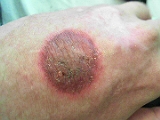| aerosol frostbite of the skin | |
|---|---|
| Other names | Aerosol-induced frostbite |
 | |
| Aerosol frostbite to the hand | |
| Specialty | Emergency medicine |
An aerosol frostbite of the skin is an injury to the body caused by the pressurized gas within an aerosol spray cooling quickly, with the sudden drop in temperature sufficient to cause frostbite to the applied area.[1] Medical studies have noted an increase of this practice, known as "frosting", in pediatric and teenage patients.[2][3]
Adiabatic expansion and/or evaporative cooling (with a low boiling temperature) causes the gas to rapidly cool on exit from the aerosol applier. In freeze sprays, a controlled amount of this cooling is useful. Uncontrolled cooling, however, can result in freeze burns to the skin. According to controlled laboratory experiments, the gas from a typical deodorant spray can reduce skin temperature by up to sixty degrees Celsius.[2]
The form of injury is freezing of the skin, a type of frostbite. It is highly advised for those who develop frostbite to seek medical attention.[4]
In rare cases aerosol-induced burns can be severe enough to necessitate skin grafting.[5]
- ^ "Brrrr! Aerosol sprays are a silly way to get frostbite - The Body Odd". Bodyodd.msnbc.msn.com. Archived from the original on 2012-05-07. Retrieved 2012-07-01.
- ^ a b May, U; Stirner, KH; Lauener, R; Ring, J; Möhrenschlager, M (2010). "Deodorant spray: A newly identified cause of cold burn". Pediatrics. 126 (3): e716–8. doi:10.1542/peds.2009-2936. PMID 20679305. S2CID 10841905. Archived from the original on 2015-06-27. Retrieved 2012-07-01.
- ^ "Deodorant burns on the increase - ABC News (Australian Broadcasting Corporation)". Abc.net.au. 2007-07-10. Archived from the original on 2020-01-11. Retrieved 2012-07-01.
- ^ "Login | Electrolube - the Solutions People" (PDF). Archived (PDF) from the original on 2015-04-02. Retrieved 2015-03-11.
- ^ Lacour, M; Le Coultre, C (1991). "Spray-induced frostbite in a child: A new hazard with novel aerosol propellants". Pediatric Dermatology. 8 (3): 207–9. doi:10.1111/j.1525-1470.1991.tb00860.x. PMID 1745629. S2CID 900852.
© MMXXIII Rich X Search. We shall prevail. All rights reserved. Rich X Search
